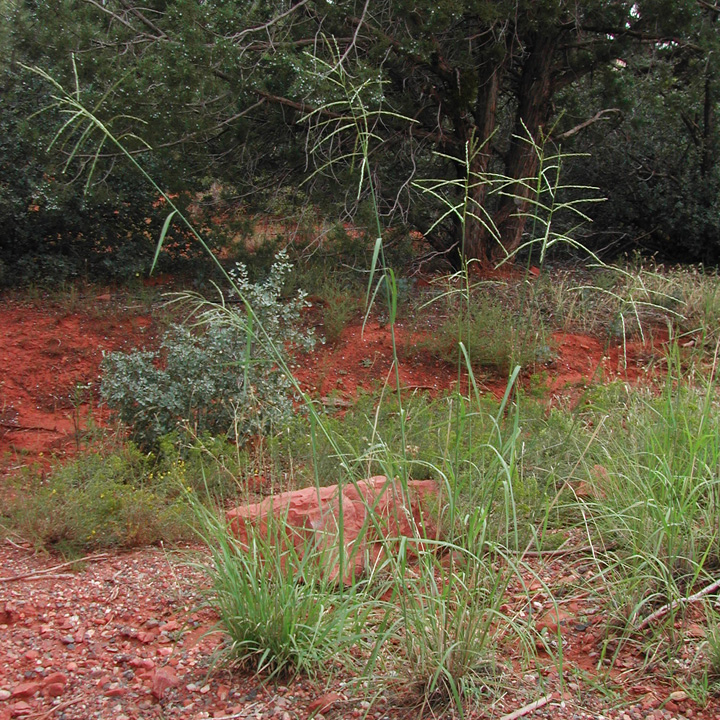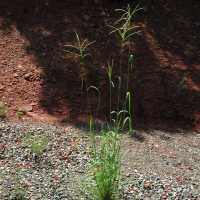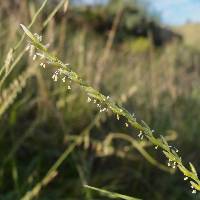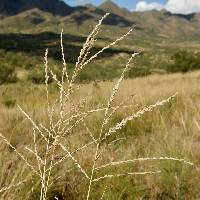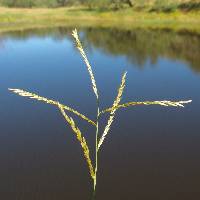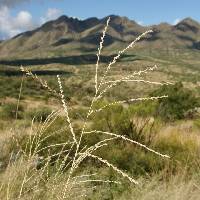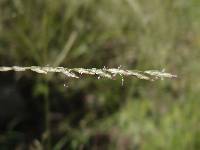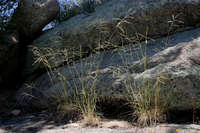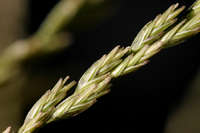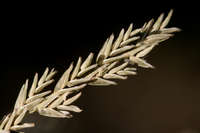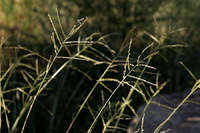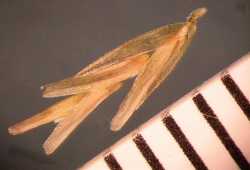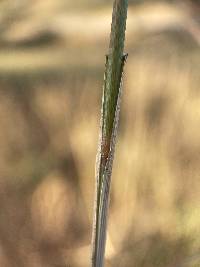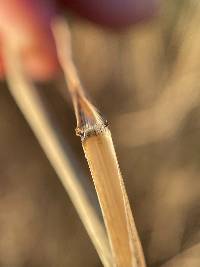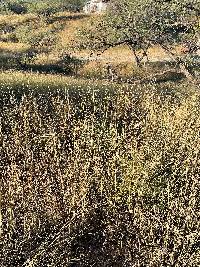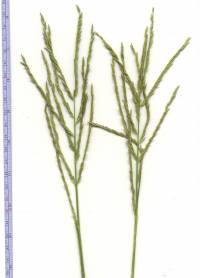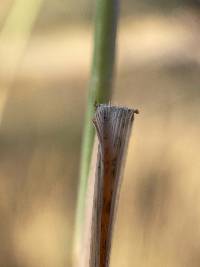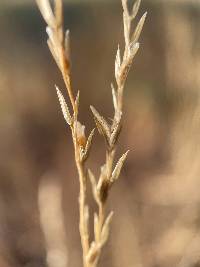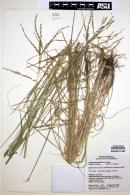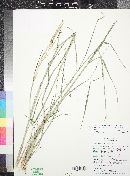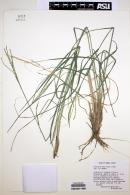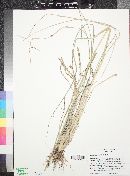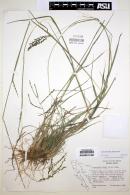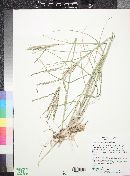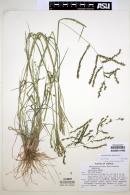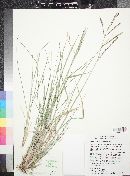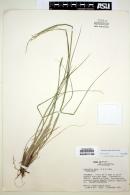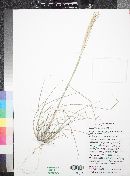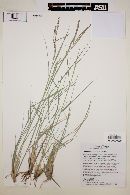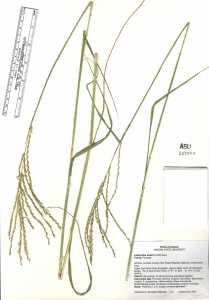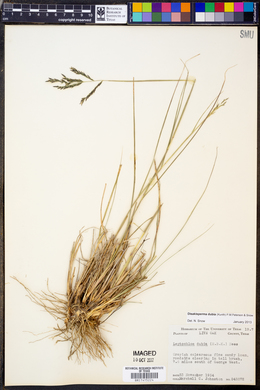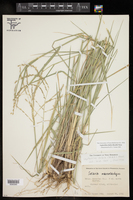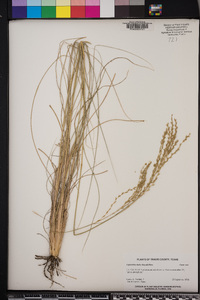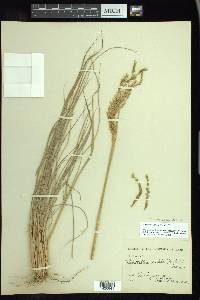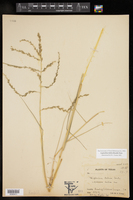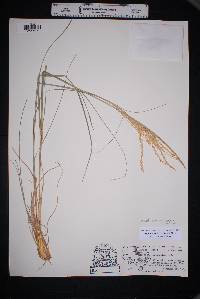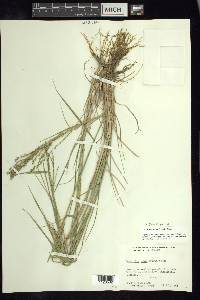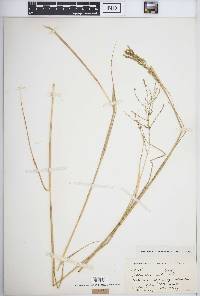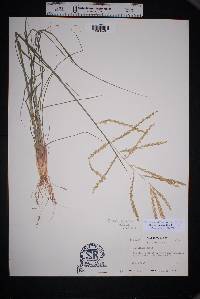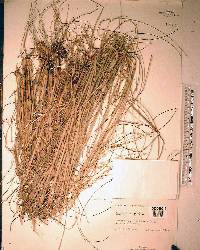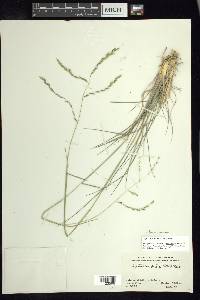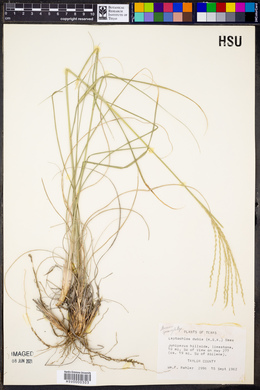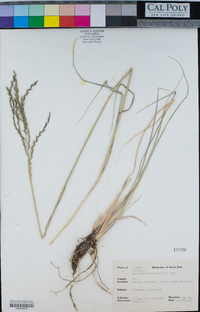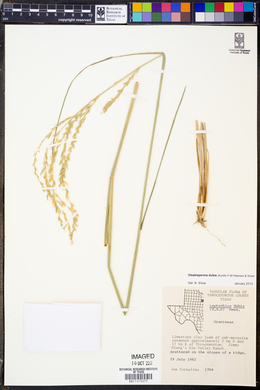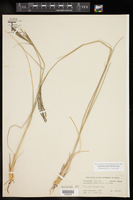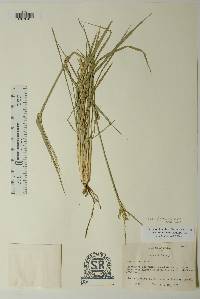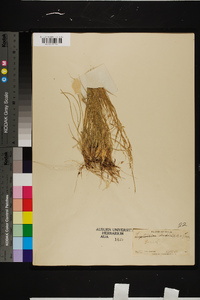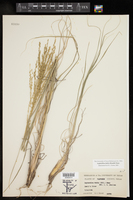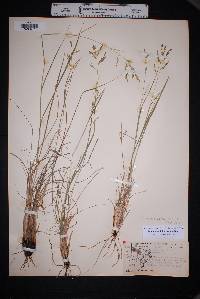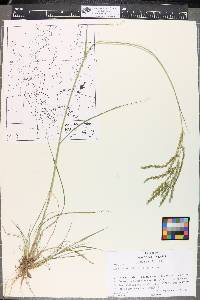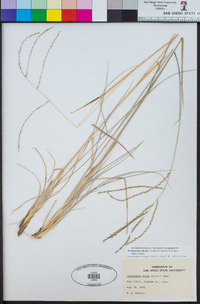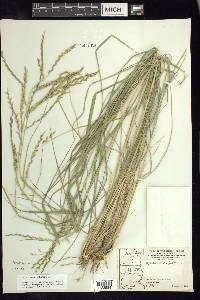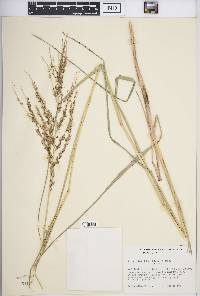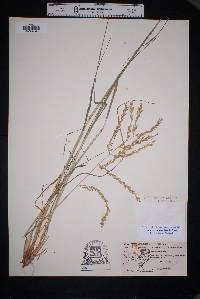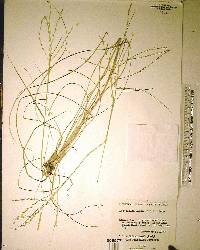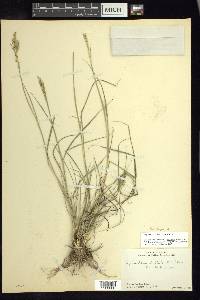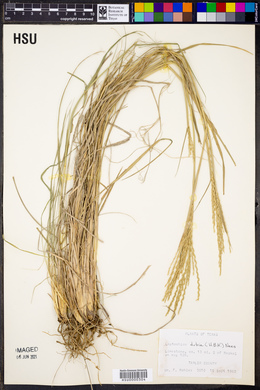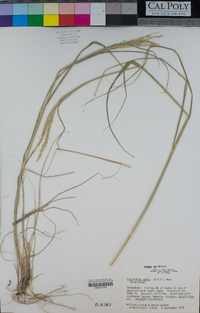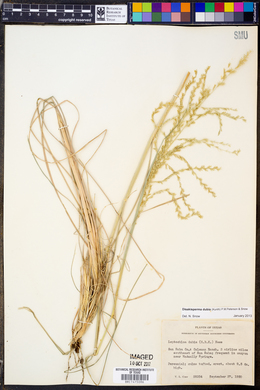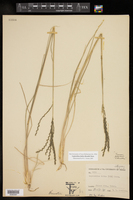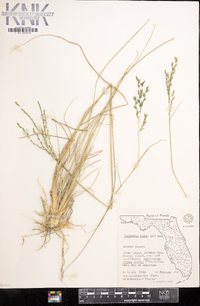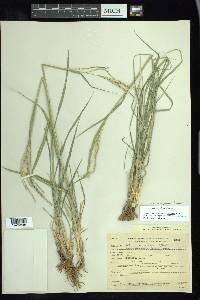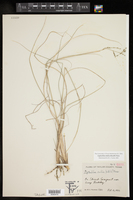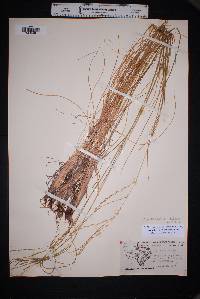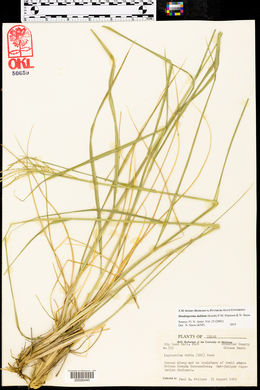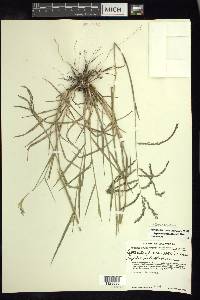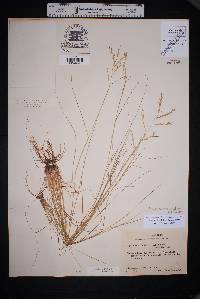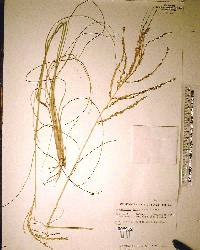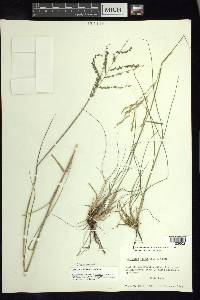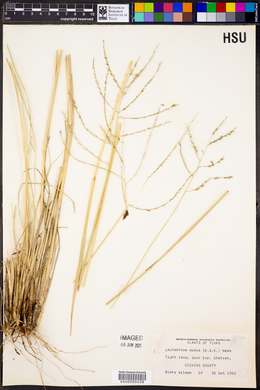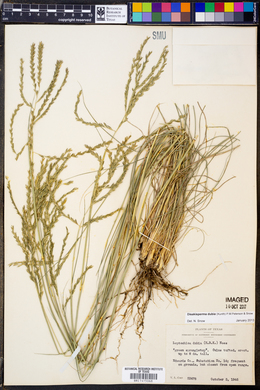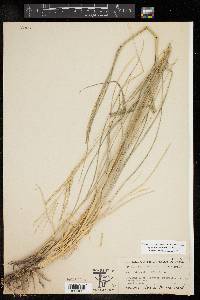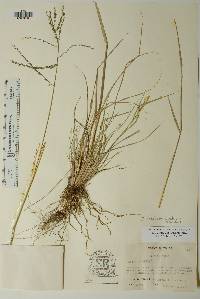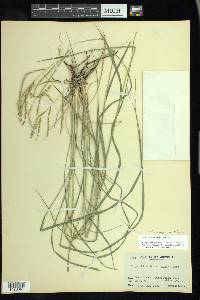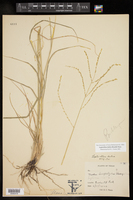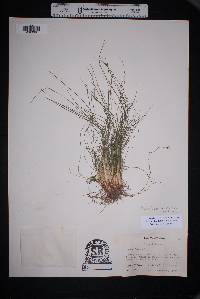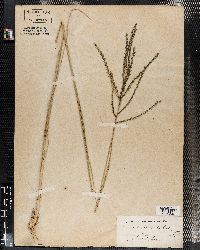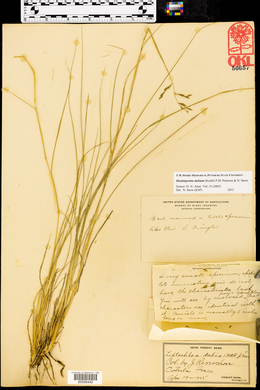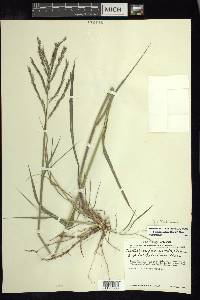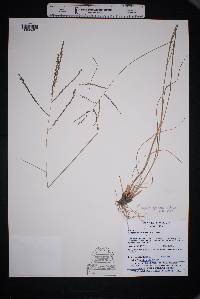Disakisperma dubium
|
|
|
|
Family: Poaceae
green sprangletop, more...Green-Sprangletop, green spangletop, Green Sprangletop (es: zacate gigante)
[Chloris dubia Kunth, moreDiplachne dubia (Kunth) Scribn., Diplachne dubia var. pringleana Kuntze, Leptochloa dubia (Kunth) Nees] |
Plants perennial. Culms (10)30-110 cm, round or basally compressed, tillering from the basal nodes, not branching from the aerial nodes, mostly glabrous, sometimes pilose basally; internodes solid. Sheaths sometimes with a pilose collar; ligules 1-2 mm, truncate, erose; blades (2)8-35 cm long, 2-8 mm wide, glabrous, strigose, or pilose. Panicles 8-20 cm, with 2-15 subdigitate or racemose branches; secondary panicles often hidden in the lowest leaf sheaths; branches 2-19 cm, ascending to spreading at maturity. Spikelets 4-12 mm, light brown to dark olive green, with 4-13 florets, often widely divergent at anthesis. Glumes narrowly triangular to ovate, acute; lower glumes 2.3-4.8 mm; upper glumes 3.3-6 mm; lemmas 3.5-5 mm, membranous, ovate to obovate, lateral veins glabrous or sericeous, hairs often restricted to the basal portion, sometimes also sericeous on the midvein and between the veins, apices obtuse to truncate, usually emarginate, unawned, sometimes mucronate; paleas ciliate on the margins; anthers 3, 0.3-1.6 mm. Caryopses 1.5-2.3 mm long, 0.9-1 mm wide, strongly dorsally compressed. 2n = 40, 60, 80. Leptochloa dubia grows from the southwestern United States and Florida through Mexico to Argentina, often in well-drained, sandy or rocky soils. It provides fair to good forage, but is seldom abundant. Dr. David Bogler, USDA NRCS PLANTS Database Perennials, Terrestrial, not aquatic, Stems nodes swollen or brittle, Stems erect or ascending, Stems geniculate, decumbent, or lax, sometimes rooting at nodes, Stems caespitose, tufted, or clustered, Stems terete, round in cross section, or polygonal, Stems compressed, flattened, or sulcate, Stems branching above base or distally at nodes, Stem internodes hollow, Stems with inflores cence less than 1 m tall, Stems with inflorescence 1-2 m tall, Stems, culms, or scapes exceeding basal leaves, Leaves mostly cauline, Leaves conspicuously 2-ranked, distichous, Leaves sheathing at base, Leaf sheath mostly open, or loose, Leaf sheath smooth, glabrous, Leaf sheath hairy at summit, throat, or collar, Leaf sheath and blade differentiated, Leaf blades linear, Leaf blades 2-10 mm wide, Leaf blades mostly flat, Leaf blade margins folded, involute, or conduplicate, Leaf blades mostly glabrous, Leaf blades more or less hairy, Ligule present, Ligule an unfringed eciliate membrane, Inflorescence terminal, Inflorescence solitary, with 1 spike, fascicle, glomerule, head, or cluster per stem or culm, Inflorescence a panicle with narrowly racemose or spicate branches, Inflorescence a panicle with digitately arranged spicate branches, Inflorescence with 2-10 branches, Inflorescence branches more than 10 to numerous, Inflorescence branches 1-sided, Inflorescence branches pa ired or digitate at a single node, Flowers bisexual, Spikelets sessile or subsessile, Spikelets laterally compressed, Spikelet less than 3 mm wide, Spikelets solitary at rachis nodes, Spikelets all alike and fertille, Spikelets bisexual, Spikelets disarticulating above the glumes, glumes persistent, Spikelets disarticulating beneath or between the florets, Spikelets secund, in rows on one side of rachis, Rachilla or pedicel glabrous, Glumes present, empty bracts, Glumes 2 clearly present, Glumes distinctly unequal, Glumes shorter than adjacent lemma, Glumes keeled or winged, Glumes 1 nerved, Lemmas thin, chartaceous, hyaline, cartilaginous, or membranous, Lemma 3 nerved, Lemma body or surface hairy, Lemma apex dentate, 2-fid, Lemma awnless, Lemma mucronate, very shortly beaked or awned, less than 1-2 mm, Lemma straight, Palea present, well developed, Palea membranous, hyaline, Palea about equal to lemma, Palea 2 nerved or 2 keeled, Stamens 3, Styles 2-fid, deeply 2-branched, Stigmas 2, Fruit - caryopsis.
FNA 2003, Gould 1980 Common Name: green sprangletop Duration: Perennial Nativity: Native Lifeform: Graminoid General: Large perennial grass, 40-150 cm in height, with tough, knotty base and well-developed roots, tillering from the basal nodes and not branching aerially, often with a purple tinge. Vegetative: Sheath open, glabrous, keeled and flattened, purple-tinged; blades 4-5 mm wide, 15-25 cm long, flat, glabrous, scabrous, or sparsely pilose; ligule membranous, ciliate, about 0.5 mm long, occasionally appearing ciliate. Inflorescence: Panicle of 2-15 spike-like branches, racemosely arranged, flexible and drooping, 4-12 cm long and well spaced on upper 5-20 cm of stem; secondary panicles often hidden in the lowest leaf sheaths. Panicle branches triangular in cross-section, bases of branches with minute hairs; spikelets 6-10 mm long and four to seven flowered; glumes lanceolate, awnless, the first glume 2-5 mm long, the second glume 3-4 mm, persistent; lemmas 3-5 mm long, glabrous or with appressed pubescent nerves, ovate or oblong, dorsally compressed; spikelets breaking apart above glumes and between florets, each floret falling with its segment of the rachis. Ecology: Found on dry slopes, plateaus, rocky slopes; 2,500-6,000 ft (762-1829 m); flowers July-October. Distribution: Much of the southern half of the US from CA east to Maryland; south to s MEX; also in South America. Notes: Until very recently this plant was known as Leptochloa dubia; it is still found under that name even in newer texts, including the Flora Neomexicana (Allred and Ivey 2012). A variable perennial which can often be quite robust to 1.5 m tall; distinguished by its larger leaf width and length, and especially the inflorescences with widely diverging, branches 2-19 cm long, sometimes at ca. 90-degree angles from the axis; each inflorescence branch has two rows of multi-flowered spikelets which upon close inspection, possess obtuse to truncate-tipped florets, usually with small notches in the ends. Ethnobotany: Forage and hay for livestock. Etymology: Disakisperma comes from the Greek words dis-, twice, -akis-, point, and -sperma, seed, alluding to the bicuspid tip of the seed; dubia means doubtful because Carl Kunth, the botanist who originally described the species, was unsure which to genus it belonged. Synonyms: Leptochloa dubia, Chloris dubia, Diplachne dubia Editor: SBuckley 2010, FSCoburn 2014, AHazelton 2015 |
|
|
|

